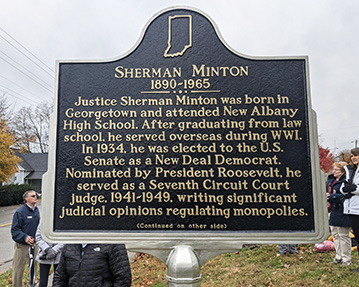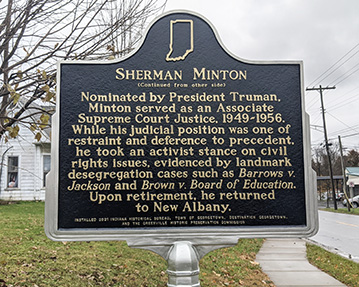

Location: Georgetown Elementary School, 8800 High St., Georgetown (Floyd County), Indiana 47122
Installed 2021 Indiana Historical Bureau, Town of Georgetown, Destination Georgetown, and the
Greenville Historic Preservation Commission
ID#: 22.2021.1
To learn more about Minton’s career, judicial philosophy, and work on important desegregation cases, see: “The Unlikely Civil Rights Legacy of Supreme Court Justice Sherman Minton” via the Indiana History Blog.
Text
Sherman Minton, 1890-1965
Side One
Justice Sherman Minton was born in Georgetown and attended New Albany High School. After graduating from law school, he served overseas during WWI. In 1934, he was elected to the U.S. Senate as a New Deal Democrat. Nominated by President Roosevelt, he served as a Seventh Circuit Court judge, 1941-1949, writing significant judicial opinions regulating monopolies.
Side Two
Nominated by President Truman, Minton served as an Associate Supreme Court Justice, 1949-1956. While his judicial position was one of restraint and deference to precedent, he took an activist stance on civil rights issues, evidenced by landmark desegregation cases such as Barrows v. Jackson and Brown v. Board of Education. Upon retirement, he returned to New Albany.
Annotated Text
Sherman Minton, 1890-1965[1]
Side One
Justice Sherman Minton was born in Georgetown[2] and attended New Albany High School.[3] After graduating from law school,[4] he served overseas during WWI.[5] In 1934, he was elected to the U.S. Senate as a New Deal Democrat.[6] Nominated by President Roosevelt, he served as a Seventh Circuit Court judge, 1941-1949, writing significant judicial opinions regulating monopolies.[7]
Side Two
Nominated by President Truman, Minton served as an Associate Supreme Court Justice, 1949-1956.[8] While his judicial position was one of restraint and deference to precedent, he took an activist stance on civil rights issues, evidenced by landmark desegregation cases such as Barrows v. Jackson and Brown v. Board of Education.[9] Upon retirement, he returned to New Albany.[10]
[1] Sherman Minton Draft Registration Card, June 1, 1917, Floyd County, Indiana, Form 522, No. 46, U.S. World War I Draft Registration Cards, 1917-1918 AncestryLibrary.com; 1900 United States Federal Census, Georgetown Township, Floyd County, Indiana, page 8, line 36, Enumeration District: 0054; FHL microfilm: 1240371, Washington, D.C.: National Archives and Records Administration, accessed AncestryLibrary.com; Indiana State Board of Health, Medical Certificate of Death for Sherman Minton, April 9, 1965, Local No. 147, State No 65 012749, Floyd County, Indiana, Death Certificates, 1900–2011, Indiana Archives and Records Administration, accessed AncestryLibrary.com.
[2] Ibid.
[3] “Students of #4 School on Old Georgetwn Road, Floyd Co., Ind.,” photograph, n.d., Indiana History Room Archives, Floyd County Library; New Albany High School, The Vista, 1909, accessed Maurer School of Law History and Archives, Indiana University, https://www.repository.law.indiana.edu/histdocs/16/; “Twenty Pupils Suspended,” Plymouth Tribune, February 25, 1909, 4, Hoosier State Chronicles.
[4] “Indiana Colleges,” Indianapolis Star, April 16, 1912, 13, Newspapers.com; “Indiana University Debaters Who Will Meet Illinois and Ohio Orators in Annual Contest,” Indianapolis News, March 13, 1913, 4, Newspapers.com; “Minton, Star Half Appears on Field,” South Bend Tribune, November 19, 1913, 12, Newspapers.com; Indiana University, The Arbutus for Nineteen Thirteen, "U.S., School Yearbooks, 1880-2012," AncestryLibrary.com; “College and School Notes,” Indianapolis News, March 10, 1914, 13, Newspapers.com; “Bryan Prize is Awarded,” Indianapolis Star, April 9, 1914, 18, Newspapers.com; “Lineup for Sunday’s Game,” Bloomington Evening World, April 23, 1915, 1, Newspapers.com; “Medic and Law Graduate List,” Bloomington Evening World, May 28, 1915, 5, Newspapers.com; “News of the Colleges,” Indianapolis News, September 29, 1915, 12, Newspapers.com; “Minton Enters Yale,” Bloomington Evening World,” September 29, 1915, 1, Newspapers.com; 1920 Alumni Directory of Yale University (New Haven: Yale University, 1920), 541, HathiTrust.
Minton attended Indiana University, 1911-1915. He earned his undergraduate degree in 1913 and law degree in 1915. He also excelled at debate and athletics. He then attended Yale University, earning his Master of Laws in 1916.
[5] Sherman Minton Draft Registration Card, June 1, 1917, Floyd County, Indiana, Form 522, No. 46, U.S. World War I Draft Registration Cards, 1917-1918 AncestryLibrary.com; “In Second Training Camp,” Indianapolis News, August 14, 1917, 3, Hoosier State Chronicles; “Indiana Seeks Games,” Terre Haute Daily Tribune, October 22, 1918, 14, Hoosier State Chronicles; “Camp Men Score in Final Frolic,” Indianapolis Star, November 26, 1917, 11, Newspapers.com; U.S. Army, Passenger List of Organizations and Casuals Returning to the United States, July 7, 1919, Records of the Office of the Quartermaster General, 1774-1985, National Archives at College Park, Record Group 92, Roll or Box 125, U.S., Army Transport Service Arriving and Departing Passenger Lists, 1910-1939, accessed AncestryLibrary.com; George Henry Nettleton, ed., Yale in the World War, Vol. 2 (New Haven: Yale University Press, 1925), 549, HathiTrust.
[6] Roosevelt Needs Minton in the United States Senate,” Indianapolis Recorder, November 3, 1934, 8, Hoosier State Chronicles; “Republicans Sweep City, County; Minton Beats Robinson in Race for Senate Seat,” Lafayette Journal and Courier, November 7, 1934, 1, Newspapers.com; “Democrats Reach New High in Senate and Have Immense Majority in House,” Hammond Times, November 7, 1934, 1, Newspapers.com; “Minton, Kern Are Victorious in Balloting,” Indianapolis Times, November 7, 1934, 1, Hoosier State Chronicles; “Sherman Minton for New Deal; Gov. McNutt Too,” Chicago Tribune, November 8, 1934, 10, Newspapers.com; “Minton Leads Lake Ticket,” Hammond Times, November 8, 1934, 1, accessed Newspapers.com.; “Minton Winner,” Boonville Enquirer, November 9, 1934, 1, accessed Newspapers.com; “Senators Agree on One Point,” Muncie Evening Press, August 6, 1937, 22, accessed Newspapers.com.; “May Use Anti-Lynch Bill in Filibuster,” Baltimore Sun, November 25, 1940, 7, accessed Newspapers.com; Congressional Record, 75th Congress, 3rd Session, 1938, vol. 83:2. 1931-45; Linda C. Gugin and James E. St. Clair, Sherman Minton: New Deal Senator, Cold War Justice (Indianapolis: Indiana Historical Society, 1997), 87-122.
Indiana voters sent Minton to Congress November 6, 1924. He took his Senate seat next to future President Harry Truman January 1935 (74th Congress). Minton was a staunch supporter of President Roosevelt and the New Deal. He served only one term in Congress, but the experience influenced his later judicial positions. As a member of a committee that investigated utility companies, he helped break up monopolies. He was a vocal critic of the Supreme Court decisions that declared several New Deal policies unconstitutional. And he became a spokesman for the administration, explaining complicated issues (like Roosevelt’s court packing plan) in plain language. Minton notably chided his party for lack of action against lynching and introduced anti-lynching legislation.
[7] “Sherman Minton Is Named to Circuit Court of Appeals,” Muncie Evening Press, May 7, 1941, 1, Newspapers.com; “Minton Proposed for U.S. Judge,” Indianapolis Star, May 8, 1941, 3, Newspapers.com; “Minton Sworn In As U.S. Judge,” Indianapolis Star, May 31, 1941, 11, Newspapers.com; “Induction Today,” Chicago Tribune, October 7, 1941, 3, Newspapers.com; “Minton Becomes U.S. Judge, Says Good-by, Politics,” Chicago Tribune, October 8, 1941, 3, Newspapers.com; “U.S. Files Antitrust Suit to Force Breakup of Giant A&P Food Chain,” Indianapolis News, September 15, 1949, 1, Newspapers.com; Gugin and St. Clair, 179-210.
On May 7, 1941, the Senate confirmed President Roosevelt’s nomination of Minton as judge of the Seventh Circuit Court of Appeals; He was sworn in May 29, 1941, and took his seat on the bench in Chicago on October 7, 1941. Minton’s judicial style on the Seventh Circuit was characterized by restraint, that is, deferring to precedent and not legislating through court decisions. He believed courts should be subjugated to the will of the people as expressed through their elected legislators. Minton’s tendency to defer to Congress meant that he often decided in favor of government agencies at the expense of individual rights. This was especially true when the decision effected (or was framed in terms of) national security. He has been strongly criticized for not buying into the “doctrine of incorporation,” that is, the idea that the Bill of Rights applied at the state level (Gugin, 199). He believed that government should regulate business and often decided against corporations engaging in monopolistic practices as exemplified by the decision in United States v. New York Atlantic and Pacific Tea Company (A & P). In 1945, he also headed the War Clemency Board, reviewing court martial sentences. And in 1948 was appointed by Truman to a three person inquiry board investigating a strike by the United Mine Workers.
[8] “Sherman Minton Named to Supreme Court,” Tipton Daily Tribune, September 15, 1949, 1, Newspapers.com; “Names Minton to High Court,” Terre Haute Tribune, September 15, 1949, 1, Newspapers.com; “Minton Is Confirmed for Court, 48 to 16,” New York Times, October 5, 1949, 1, timesmachine.nytimes.com; “Hoosier Sworn In As Supreme Court Justice,” Muncie Evening Press, October 12, 1949, 1, Newspapers.com; “Minton Sworn In As Supreme Court Justice,” New York Times, October 13, 1949, 18, timesmachine.nytimes.com; “Minton to Quit Post in Supreme Court,” Evansville Courier and Press, September 8, 1956, 9, Newspapers.com; “Bust of Sherman Minton to be Dedicated Dec. 21,” Indianapolis Star, December 14, 1956, 18, Newspapers.com.
In September 1949, President Harry Truman nominated Sherman Minton, his old friend from their years in the Senate, for the Supreme Court of the United States. Minton was confirmed and took his place on the bench that October.
[9] Supreme Court of the United States, Barrows Et Al. v. Jackson, June 15, 1953, U.S. Reports: Barrows v. Jackson, 346 U.S. 249, Library of Congress, https://www.loc.gov/item/usrep346249/; Supreme Court of the United States, Barrows et al. v. Jackson, Decided June 15, 1953, 346 U.S. 249, Legal Information Institute, Cornell Law School; “Supreme Court to Hear Case on Covenants,” Alabama Tribune, April 24, 1953, 5, Newspapers.com; “Laud Loren Miller in Housing Victory,” California Eagle (Los Angeles), June 18, 1953, 1, Newspapers.com; “Supreme Court Bans Covenant Damage Suits” California Eagle (Los Angeles), June 18, 1953, 1, Newspapers.com; Supreme Court of the United States, Oliver Brown, et al., Appellants, v. Board of Education of Topeka, Shawnee County, Kansas, et al., May 17, 1954, Appellate Jurisdiction Case Files, 1792 – 2010, Records of the Supreme Court of the United States, Record Group 267, National Archives, https://catalog.archives.gov/id/1656510; Supreme Court of the United States, Brown et al. v. Board of Education of Topeka et al., Decided May 17, 1954, 347 U.S. 483, Legal Information Institute, Cornell Law School; “Text of Supreme Court Decision Outlawing Negro Segregation in the Public Schools,” New York Times, May 18, 1954, 15, timesmachine.nytimes.com; David N. Atkinson, “Justice Sherman Minton and the Protection of Minority Rights,” Washington and Lee Law Review 34, iss. 1 (1997): 97-117, accessed Washington and Lee University School of Law Scholarly Commons.
As an Associate Justice of the Supreme Court, Minton maintained a general position of restraint, tendency to side with legislative precedent and the administration against individuals, and his disinclination to overturn the rulings of state courts. Despite this determination, Minton maintained a consistently strong, activist position when it came to civil rights issues, especially desegregation, as evidenced by landmark cases such Brown v. Board of Education of Topeka and Barrows v. Jackson. Minton wrote the majority opinion for the 1953 case of Barrows v. Jackson, which provides insight into his judicial philosophy. For more information, see: Jill Weiss Simins, “The Unlikely Civil Rights Legacy of Supreme Court Justice Sherman Minton,” Indiana History Blog, July 6, 2021, https://blog.history.in.gov/the-unlikely-civil-rights-legacy-of-supreme-court-justice-sherman-minton/.
[10] “Indiana Bar to Honor Judge Sherman Minton,” Logansport Pharos-Tribune, February 4, 1956, 11, Newspapers.com; “Minton to Step Down from Supreme Court,” Indianapolis News, September 7, 1956, 1, Newspapers.com; “Minton to Quit Post in Supreme Court,” Evansville Courier and Press, September 8, 1956, 9, Newspapers.com; “Justice Minton Plans to Retire Next Month,” Muncie Star Press, September 8, 1956, 1, Newspapers.com.
